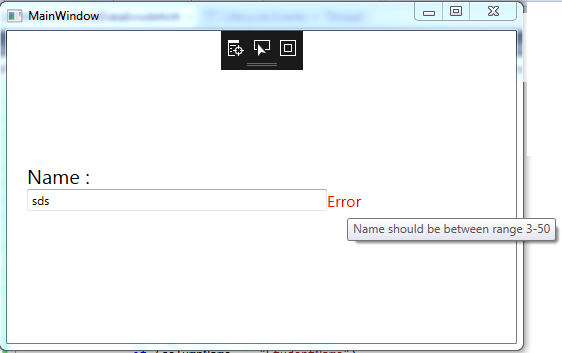【WPF 数据验证机制】二、Validation 数据验证 简单使用
上一篇:【WPF】一、WPF 数据验证机制 Validation---重要
只设计Mvvm的View层和Viewmodel层,未设计到model。下面一篇重点介绍IDataErrorInfo|INOtyfyDataErrorInfo +数据标注的联合使用,主要在model层
- By using Exception validation
- By using IDataErrorInfo
- By using ValidationRules
- By using INotifyDataErrorInfo
By Using Exception Validation
The View
<TextBox Text="{Binding StudentName, ValidatesOnExceptions=True, UpdateSourceTrigger=PropertyChanged}" VerticalAlignment="Center" FontSize="20"/>
The Code behind View
namespace TestWpfValidation { public partial class MainWindow : Window { private string _studentName; public string StudentName { get { return _studentName; } set { if (value.Length < 6 || value.Length > 50) { throw new ArgumentException("Name should be between range 6-50"); } _studentName = value; } } public MainWindow() { this.DataContext = this; InitializeComponent(); } } }
Output

By Using IDataErrorInfo
The View
TextBox Text="{Binding StudentName,
UpdateSourceTrigger=PropertyChanged, ValidatesOnDataErrors=True}"
VerticalAlignment="Center"
FontSize="20"/>
The ViewModel
public partial class MainWindow : Window, IDataErrorInfo, INotifyPropertyChanged { public MainWindow() { this.DataContext = this; InitializeComponent(); } public string StudentName { get { return _studentName; } set { _studentName = value; OnPropertyChanged("StudentName"); } } public string this[string columnName] { get { switch (columnName)
{
case "Age":
if (this.Age < 10 || this.Age > 100)
return "The age must be between 10 and 100";
break;
} return result; } } public string Error { get { return string.Empty; } } public event PropertyChangedEventHandler PropertyChanged; protected void OnPropertyChanged(string name) { PropertyChangedEventHandler handler = PropertyChanged; if (handler != null) { handler(this, new PropertyChangedEventArgs(name)); } } private string _studentName; }
By Using ValidationRules
public class StudentNameValidationRule : ValidationRule { public override ValidationResult Validate(object value, CultureInfo cultureInfo) { string valueToValidate = value as string; if (valueToValidate.Length < 6 || valueToValidate.Length > 10) { return new ValidationResult(false, "Name should be between range 3-50"); } return new ValidationResult(true, null); } }
In XAML,
<TextBox VerticalAlignment="Center" FontSize="20"> <TextBox.Text> <Binding Path="StudentName" UpdateSourceTrigger="PropertyChanged"> <Binding.ValidationRules> <local:StudentNameValidationRule/> </Binding.ValidationRules> </Binding> </TextBox.Text> <TextBox>
Adding Style to the Error
<Style x:Key="GeneralErrorStyle"> <Setter Property="Validation.ErrorTemplate"> <Setter.Value> <ControlTemplate> <DockPanel> <TextBlock DockPanel.Dock="Right" Foreground="Red" FontSize="12pt" Text="Error" ToolTip="{Binding ElementName=placeholder, Path= AdornedElement.(Validation.Errors)[0].ErrorContent}"/> <AdornedElementPlaceholder x:Name="placeholder" /> </DockPanel> </ControlTemplate> </Setter.Value> </Setter> </Style>
XaML
<TextBox Style="{StaticResource GeneralErrorStyle}" Text="{Binding StudentName, UpdateSourceTrigger=PropertyChanged, ValidatesOnDataErrors=True}" HorizontalAlignment="Left" Width="300"/>

INotifyDataErrorInfo
接口
public interface INotifyDataErrorInfo { bool HasErrors { get; } event EventHandler<DataErrorsChangedEventArgs> ErrorsChanged; IEnumerable GetErrors(string propertyName); }
Multiple errors per property
编程是个人爱好



